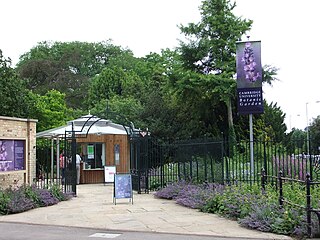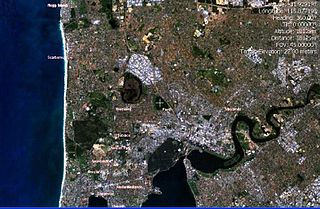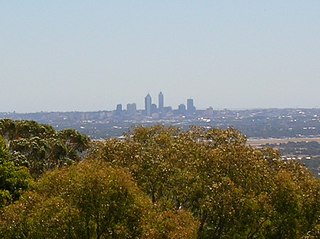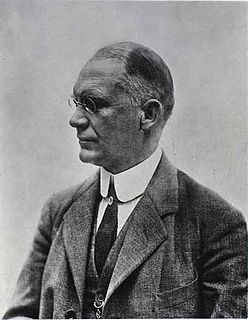
The Cambridge University Botanic Garden is a botanical garden located in Cambridge, England associated with the university Department of Plant Sciences. It lies between Trumpington Road to the west, Bateman Street to the north and Hills Road to the east.

Nuytsia floribunda is a hemiparasitic tree found in Western Australia. The species is known locally as moodjar and, more recently, the Christmas tree, as the display of intensely bright flowers during the austral summer coincides with the Christmas season.

Thornlie railway station is a railway station on the Transperth network. It is the terminus of the Thornlie spur of the Armadale line, seventeen kilometres from Perth station serving the suburb of Thornlie.

Banksia ilicifolia, commonly known as holly-leaved banksia, is a tree in the family Proteaceae. Endemic to southwest Western Australia, it belongs to Banksia subg. Isostylis, a subgenus of three closely related Banksia species with inflorescences that are dome-shaped heads rather than characteristic Banksia flower spikes. It is generally a tree up to 10 metres (33 ft) tall with a columnar or irregular habit. Both the scientific and common names arise from the similarity of its foliage to that of the English holly Ilex aquifolium; the glossy green leaves generally have very prickly serrated margins, although some plants lack toothed leaves. The inflorescences are initially yellow but become red-tinged with maturity; this acts as a signal to alert birds that the flowers have opened and nectar is available.

Lake Monger is a large urban wetland on the Swan Coastal Plain in suburban Perth, Western Australia nestled between the suburbs of Leederville, Wembley and Glendalough.

The Swan Coastal Plain in Western Australia is the geographic feature which contains the Swan River as it travels west to the Indian Ocean. The coastal plain continues well beyond the boundaries of the Swan River and its tributaries, as a geological and biological zone, one of Western Australia's Interim Biogeographic Regionalisation for Australia (IBRA) regions. It is also one of the distinct physiographic provinces of the larger West Australian Shield division.
Frederica Lucy "Rica" Erickson, née Sandilands, was an Australian naturalist, botanical artist, historian, author and teacher. Without any formal scientific training, she wrote extensively on botany and birds, as well as genealogy and general history. Erickson authored ten books, co-authored four, was editor of twelve, and author or co-author of numerous papers and articles that have been printed in popular, scientific and encyclopaedic publications.

Banksia menziesii, commonly known as firewood banksia, is a species of flowering plant in the genus Banksia. It is a gnarled tree up to 10 m (33 ft) tall, or a lower spreading 1–3 m (3.3–9.8 ft) shrub in the more northern parts of its range. The serrated leaves are dull green with new growth a paler grey green. The prominent autumn and winter inflorescences are often two-coloured red or pink and yellow, and their colour has given rise to more unusual common names such as port wine banksia and strawberry banksia. Yellow blooms are rarely seen.

Banksia telmatiaea, commonly known as swamp fox banksia or rarely marsh banksia, is a shrub that grows in marshes and swamps along the lower west coast of Australia. It grows as an upright bush up to 2 metres tall, with narrow leaves and a pale brown flower spike, which can produce profuse quantities of nectar. First collected in the 1840s, it was not published as a separate species until 1981; as with several other similar species it was previously included in B. sphaerocarpa.
Charles Austin Gardner was a Western Australian botanist.

Esperance Plains, also known as Eyre Botanical District, is a biogeographic region in southern Western Australia on the south coast between the Avon Wheatbelt and Hampton regions, and bordered to the north by the Mallee region. It is a plain punctuated by granite and quartz outcrops and ranges, with a semi-arid Mediterranean climate and vegetation consisting mostly of mallee-heath and proteaceous scrub. About half of the region has been cleared for intensive agriculture. Recognised as a bioregion under the Interim Biogeographic Regionalisation for Australia (IBRA), it was first defined by John Stanley Beard in 1980.

Mallee, also known as Roe Botanical District, is a biogeographic region in southern Western Australia. Located between the Esperance Plains, Avon Wheatbelt and Coolgardie regions, it has a low, gently undulating topography, a semi-arid mediterranean climate, and extensive Eucalyptus mallee vegetation. About half of the region has been cleared for intensive agriculture. Recognised as a region under the Interim Biogeographic Regionalisation for Australia (IBRA), it was first defined by John Stanley Beard in 1980.
The Western Australian Flora – A Descriptive Catalogue was published by the Wildflower Society of Western Australia, the Western Australian Herbarium, CALM, and the Botanic Gardens and Parks Authority of Perth, Western Australia.

Carl Emil Hansen Ostenfeld was a Danish systematic botanist. He graduated from the University of Copenhagen under professor Eugenius Warming. He was a keeper at the Botanical Museum 1900-1918, when he became professor of botany at the Royal Veterinary and Agricultural University. In 1923, by the early retirement of Raunkiær's, Ostenfeld became professor of botany at the University of Copenhagen and director of the Copenhagen Botanical Garden, both positions held until his death in 1931. He was a member of the Royal Danish Academy of Sciences and Letters and served on the board of directors of the Carlsberg Foundation.

The Drummond Nature Reserve is an A class nature reserve 10 kilometres west of Bolgart, Western Australia. Named after the botanist James Drummond, the reserve has 439 species of vascular plants within its boundaries, including two rare and seven priority species.

Adenanthos cuneatus, also known as coastal jugflower, flame bush, bridle bush and sweat bush, is a shrub of the family Proteaceae native to the south coast of Western Australia. The French naturalist Jacques Labillardière originally described it in 1805. Within the genus Adenanthos, it lies in the section Adenanthos and is most closely related to A. stictus. A. cuneatus has hybridized with four other species of Adenanthos. Growing to 2 m high and wide, it is erect to prostrate in habit, with wedge-shaped lobed leaves covered in fine silvery hair. The single red flowers are insignificant, and appear all year, though especially in late spring. The reddish new growth occurs over the summer.
Mildred Esther Mathias was an American botanist and professor.
Richard Brinsley Hinds FRCS was a British naval surgeon, botanist and malacologist. He sailed on the 1835–42 voyage by HMS Sulphur to explore the Pacific Ocean, and edited the natural history reports of that expedition.
Barbara Lynette Rye is an Australian botanist born in 1952.

Kensington bushland reserve is a significant remnant of Swan Coastal Plain vegetation, that has been reserved in the suburb of Kensington, in Perth, Western Australia, by the state government.


















